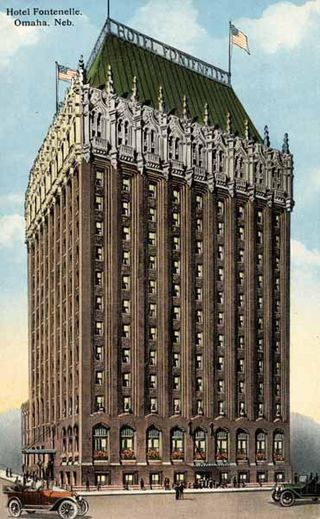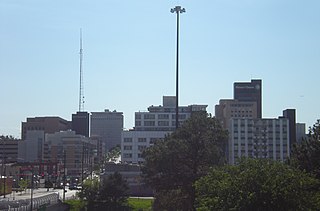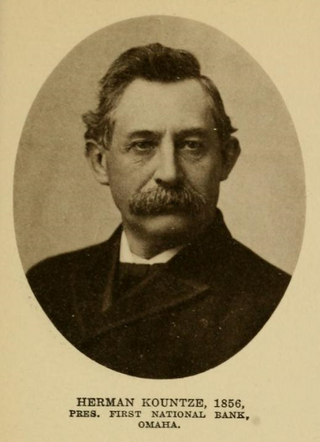Related Research Articles

North Omaha is a community area in Omaha, Nebraska, in the United States. It is bordered by Cuming and Dodge Streets on the south, Interstate 680 on the north, North 72nd Street on the west and the Missouri River and Carter Lake, Iowa on the east, as defined by the University of Nebraska at Omaha and the Omaha Chamber of Commerce.
Florence is a neighborhood in Omaha, Nebraska, United States on the city's north end and originally one of the oldest cities in Nebraska. It was incorporated by the Nebraska Territorial Legislature on March 10, 1857. The site of Winter Quarters for Mormon migrants traveling west, it has the oldest cemetery for people of European descent and oldest standing gristmill in Nebraska. Florence was the site of an illegal territorial legislature in 1858. Given the high concentration of National Register of Historic Places in the neighborhood, it is regarded as "the historic front door to Omaha as well as the state."
North Omaha, Nebraska has a recorded history spanning over 200 years, pre-dating the rest of Omaha, encompassing wildcat banks, ethnic enclaves, race riots and social change. North Omaha has roots back to 1812 and the founding of Fort Lisa. It includes the Mormon settlement of Cutler's Park and Winter Quarters in 1846, a lynching before the turn of the twentieth century, the thriving 24th Street community of the 1920s, the bustling development of its African-American community through the 1950s, a series of riots in the 1960s, and redevelopment in the late 20th and early 21st century.
Significant events in the history of North Omaha, Nebraska include the Pawnee, Otoe and Sioux nations; the African American community; Irish, Czech, and other European immigrants, and; several other populations. Several important settlements and towns were built in the area, as well as important social events that shaped the future of Omaha and the history of the nation. The timeline of North Omaha history extends to present, including recent controversy over schools.

The history of Omaha, Nebraska, began before the settlement of the city, with speculators from neighboring Council Bluffs, Iowa staking land across the Missouri River illegally as early as the 1840s. When it was legal to claim land in Indian Country, William D. Brown was operating the Lone Tree Ferry to bring settlers from Council Bluffs to Omaha. A treaty with the Omaha Tribe allowed the creation of the Nebraska Territory, and Omaha City was founded on July 4, 1854. With early settlement came claim jumpers and squatters, and the formation of a vigilante law group called the Omaha Claim Club, which was one of many claim clubs across the Midwest. During this period many of the city's founding fathers received lots in Scriptown, which was made possible by the actions of the Omaha Claim Club. The club's violent actions were challenged successfully in a case ultimately decided by the U.S. Supreme Court, Baker v. Morton, which led to the end of the organization.
The neighborhoods of Omaha are a diverse collection of community areas and specific enclaves. They are spread throughout the Omaha metro area, and are all on the Nebraska side of the Missouri River.

The Prospect Hill Cemetery, located at 3202 Parker Street in the Prospect Hill neighborhood of North Omaha, Nebraska, United States, is believed to be the oldest pioneer cemetery in Omaha. It is between 31st and 33rd Streets and Parker and Grant Streets.
The Nebraska Territorial Legislature was held from January 16, 1855 until 1865 in Omaha City, Nebraska Territory.
Baker v. Morton, 79 U.S. 150 (1870), was the second of two land claim suits to come out of Omaha, Nebraska Territory, filed in September 1860, prior to statehood. A claim jumper filed suit against local land barons to stake out a homestead in the area that was to become the city of Omaha. The case was important for establishing homesteaders' rights and ensuring that the future growth of Omaha would benefit everyone, not just wealthy landowners and speculators.

Midtown is a geographic area of Omaha, Nebraska that is a culturally, socially and economically important area of the city. It is home to major research centers, national corporations, several historic districts, and a number of historic residences.
Scriptown was the name of the first subdivision in the history of Omaha, which at the time was located in Nebraska Territory. It was called "Scriptown" because scrip was used as payment, similar to how a company would pay employees when regular money was unavailable. Its original survey placed the location from the Missouri River to North 30th Street, Cuming to Fort Street.
Gifford Park is a historic neighborhood in midtown Omaha, Nebraska. It is roughly bounded by the North Freeway on the east, North 38th Street on the west, Dodge Street on the south and Cuming Street on the north. Its namesake park was added to the City parks network in 1916. The neighborhood is bounded by several historic neighborhoods, including Bemis Park, Gold Coast, and the Near North Side.

Herman Kountze was a powerful and influential pioneer banker in Omaha, Nebraska, during the late 19th century. After organizing the Kountze Brothers Bank in 1857 as the second bank in Omaha, Herman and his brothers Augustus, Charles and Luther changed the charter in 1863, opening the First National Bank of Omaha that year. Kountze was involved in a number of influential ventures around Omaha, including the development of the Omaha Stockyards and the Trans-Mississippi and International Exposition of 1898. Immediately after his death Kountze was regarded as one of Omaha's "old settlers". Today Kountze's First National Bank is the oldest bank west of the Mississippi River, and continues as a privately held company in its sixth generation of family ownership.
Claim clubs, also called actual settlers' associations or squatters' clubs, were a nineteenth-century phenomenon in the American West. Usually operating within a confined local jurisdiction, these pseudo-governmental entities sought to regulate land sales in places where there was little or no legal apparatus to deal with land-related quarrels of any size. Some claim clubs sought to protect squatters, while others defended early land owners. In the twentieth century, sociologists suggested that claim clubs were a pioneer adaptation of democratic bodies on the East Coast, including town halls.
The Lone Tree Ferry, later known as the Council Bluffs and Nebraska Ferry Company, was the crossing of the Missouri River at Council Bluffs, Iowa, and Omaha, Nebraska, US, that was established in 1850 by William D. Brown. Brown was the first pioneer to see the potential for a city on the site, and the landing became a popular gathering site for the first settlers of the Nebraska Territory. Named after a solitary tree on the Nebraska bank of the river, the Lone Tree Ferry became central to the founding and development of the City of Omaha.
William D. Brown was the first pioneer to envision building a city where Omaha, Nebraska sits today. Many historians attribute Brown to be the founder of Omaha, although this has been disputed since the late nineteenth century. Alfred D. Jones, the first postmaster of Omaha, laid strong claims to the title himself, suggesting that he told Brown about the potential for a town. Brown was also a member of the Second Territorial Legislature for the Nebraska Territory.

Alfred D. Jones was a late 19th-century lawyer, surveyor and politician in the Midwestern United States. In 1846 he platted Fort Des Moines, Iowa, and in 1854 he platted Omaha, Nebraska. He became the first settler in Omaha, as well as the first postmaster, a member of the first Omaha City Council and the first Omaha School Board, and was among the first legislators of the Nebraska Territory.
Andrew Jackson Hanscom was a pioneer, lawyer, politician, and real estate broker from Omaha, Nebraska.
Significant events in the history of Omaha, Nebraska, include social, political, cultural, and economic activities.
References
- 1 2 3 4 (1954) "New City Shapes Up on a Muddy Plateau; 'Claims Club' Is Ruler", Omaha's First Century. Omaha World-Herald. Retrieved 7/14/07.
- 1 2 3 Morton, J. and Watkins, A. (1918) "Nebraska Claim Meeting," History of Nebraska from the Earliest Explorations of the Trans-Mississippi Region. Lincoln, NE: Western Publishing and Engraving Company. p. 188. Retrieved 7/15/07.
- 1 2 3 4 Sheldon, A.E. (1904) "Chapter VII: Nebraska Territory," Archived 2004-12-26 at the Wayback Machine Semi-Centennial History of Nebraska. Lincoln, NE: Lemon Publishing. Retrieved 7/14/07.
- 1 2 3 United States Supreme Court. (1912) "Baker v. Morton," United States Supreme Court Reports. Lawyers Co-operative Publishing Company. p. 150-159.
- 1 2 3 Larsen, L. and Cottrell, B. (1997) The Gate City: A History of Omaha. University of Nebraska Press. p. 43.
- ↑ Reeves, R. (nd) "Omaha - Douglas County," Archived 2011-07-20 at the Wayback Machine Virtual Nebraska - Our Towns. University of Nebraska - Lincoln. Retrieved 7/15/07.
- ↑ Linn, William Alexander (1902). The Story of the Mormons. p. 375.
- ↑ (nd) "Treaty with the Omaha: March 16, 1854," First Peoples. Retrieved 7/15/07.
- ↑ Larsen, L. and Cottrell, B. (1997) The Gate City: A History of Omaha. University of Nebraska Press. p. 9.
- ↑ "First Settler in Omaha", The New York Times . January 19, 1903. Retrieved 6/17/08.
- ↑ Cavanaugh, J.F. (2003) "Farnam 1872", Early Omaha: Gateway to the West. Omaha Public Library. Retrieved 7/14/07.
- 1 2 Sorenson, A. (1874) "Chapters XIV - XVII: Early history of Omaha" Archived 2007-06-26 at the Wayback Machine , Early History Of Omaha; or Walks And Talks Among The Old Settlers: A Series of Sketches in the Shape of a Connected Narrative of the Events and Incidents of Early Times in Omaha together with a Brief Mention of the Most Important Events of Later Years. Omaha Bee Publisher. p. 104. Retrieved 7/14/07.
- 1 2 3 Welch, M. (1940) "Douglas County," "Who's Who in Nebraska." p. 298. Retrieved 7/15/07.
- 1 2 Bristow, D. (1997) A Dirty, Wicked Town: Tale of 19th Century Omaha. Caxton Press. p. 40.
- 1 2 3 Rea, L. (nd) "History of Omaha/Douglas County" Archived 2007-09-27 at the Wayback Machine , Douglas County Historical Society. Retrieved 7/14/07.
- ↑ (nd) Johnson's History of Nebraska p. 284. Retrieved 6/7/07.
- ↑ (1898) Transactions and reports of the Nebraska State Historical Society: Volume IV. Lincoln, NE: State Journal Printers.
- ↑ (1954) "New City Shapes Up on a Muddy Plateau; 'Claims Club' Is Ruler", Omaha's First Century. Omaha World-Herald. Retrieved 7/14/07.
- ↑ Purviance, E.E. (nd) "A Pioneer Family," Pioneer Women of America. Retrieved 7/19/07.
- ↑ Sorenson, A. (1874) "Chapters XIV - XVII: Early history of Omaha" Archived 2007-06-26 at the Wayback Machine , Early History Of Omaha; or Walks And Talks Among The Old Settlers: A Series of Sketches in the Shape of a Connected Narrative of the Events and Incidents of Early Times in Omaha together with a Brief Mention of the Most Important Events of Later Years. Omaha Bee Publisher. p. 106. Retrieved 7/14/07.
- ↑ Sorenson, A. (1874) "Chapters XIV - XVII: Early history of Omaha" Archived 2007-06-26 at the Wayback Machine , Early History Of Omaha; or Walks And Talks Among The Old Settlers: A Series of Sketches in the Shape of a Connected Narrative of the Events and Incidents of Early Times in Omaha together with a Brief Mention of the Most Important Events of Later Years. Omaha Bee Publisher. p. 109. Retrieved 7/14/07.
- ↑ Shavell, S. (2005) "Contracts, Holdup, and Legal Intervention". Harvard Law School. Retrieved 7/14/07.
- ↑ Bristow, D. (1997) A Dirty, Wicked Town: Tale of 19th Century Omaha. Caxton Press. p. 42.
- 1 2 Sorenson, A. (1874) "Chapters XIV - XVII: Early history of Omaha" Archived 2007-06-26 at the Wayback Machine , Early History Of Omaha; or Walks And Talks Among The Old Settlers: A Series of Sketches in the Shape of a Connected Narrative of the Events and Incidents of Early Times in Omaha together with a Brief Mention of the Most Important Events of Later Years. Omaha Bee Publisher. p. 110. Retrieved 7/14/07.
- ↑ Johnson, H. (1879) "Claim Club", Johnson's History of Nebraska. Omaha, NE: Herald Printing House. p. 287. Retrieved 7/14/07. Archived January 11, 2007, at the Wayback Machine
- ↑ Olson, J. and Naugle, R.C. (1997) "Territorial growth and development," History of Nebraska. University of Nebraska Press. p. 90.
